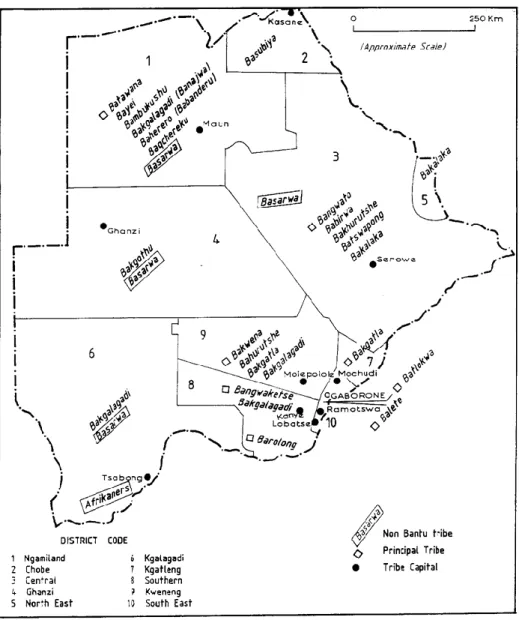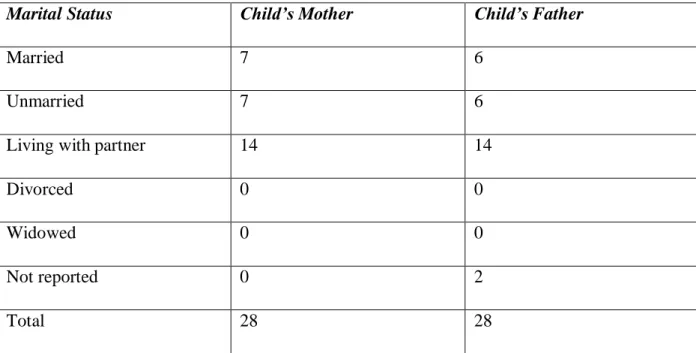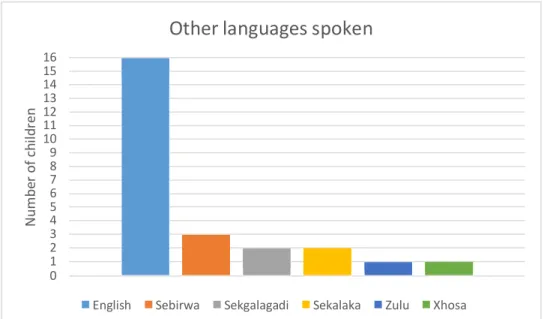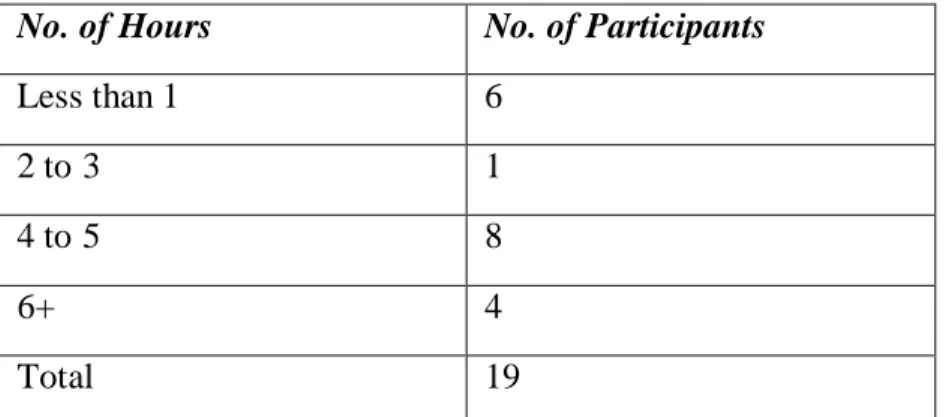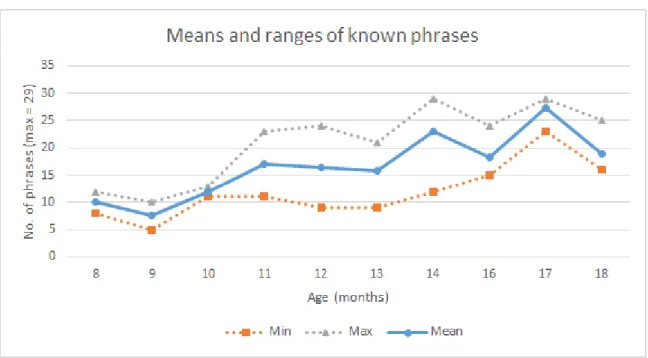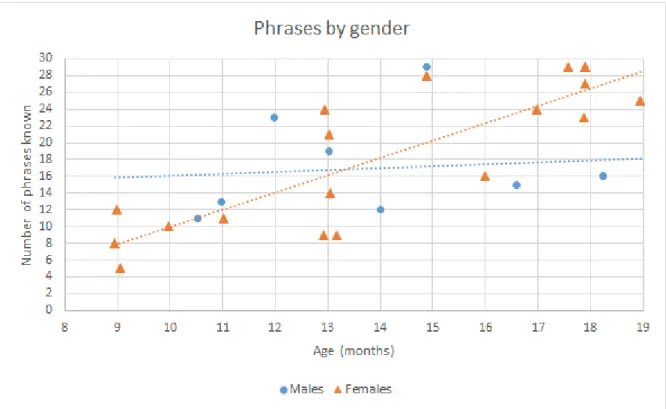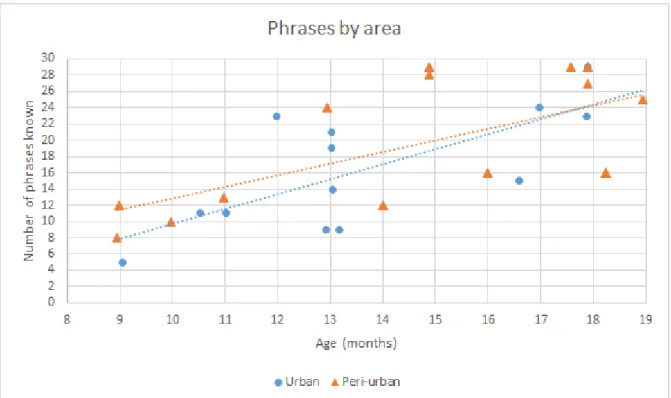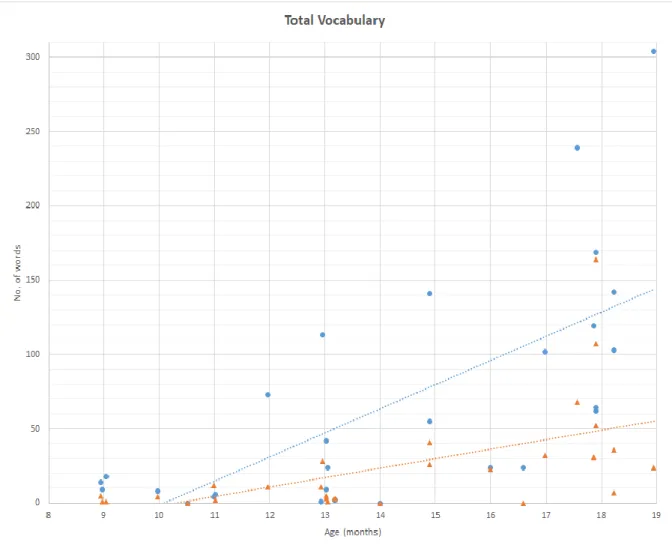Children at 8 months old knew an average of 17.5 actions/gestures, which increased to an average of 46.3 actions/gestures by 18 months. Opinions expressed and conclusions reached are those of the author and should not necessarily be attributed to the NRF.
Literature review
Research Design
Child and family demographics Table 4.1.a Gender and area distribution
Results
Discussion
INTRODUCTION
Research Aim and Questions
Background to Botswana
By the year 2002, the national average of people living in absolute poverty - or below the 'dollar a day' line - was just under a quarter of the total population (Statistics Botswana, 2004).
Languages in Botswana
- Description of Setswana
It is the national language of Botswana, one of the 11 official languages of South Africa, and is also a recognized language in both Namibia and Zimbabwe, where it is spoken by a small minority (Eberhard, Simons, & Fennig, 2019). However, they are considered a minority as they are not one of the eight Setswana tribes.
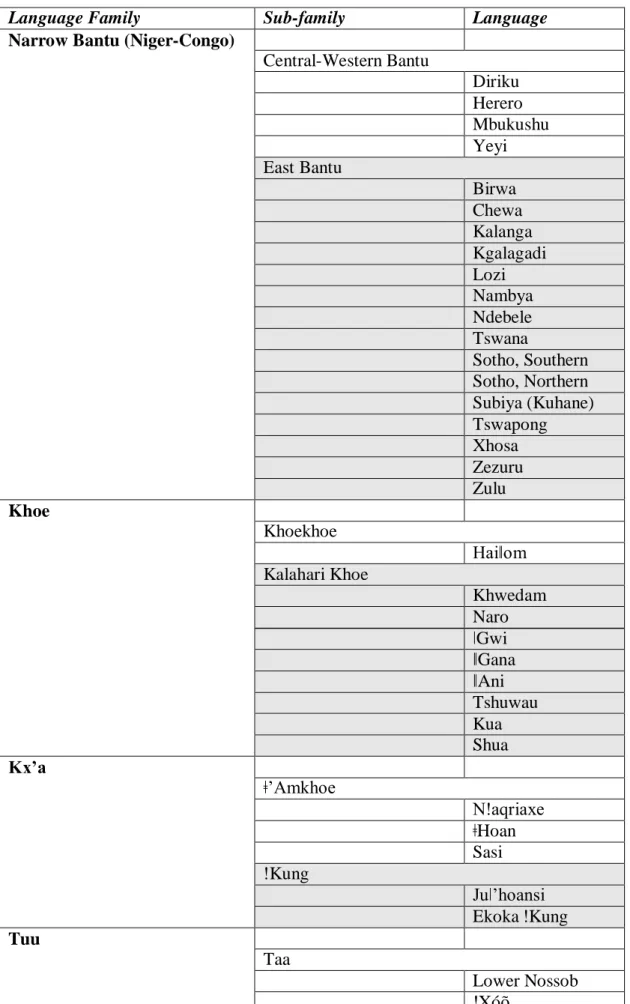
LITERATURE REVIEW
The Acquisition of Setswana and Related Languages
Two studies have been conducted on Setswana lexical development, particularly with regard to specific semantic categories. Several studies have been completed on the development of aspects such as prosody and tone (see Demuth, 1995), phonology (Demuth, 2007); passive constructions (cf.
Measuring Language Acquisition in Children
- The MacArthur-Bates Communicative Development Inventory
- CDI development in sub-Saharan Africa
Children must learn to produce and understand many forms of nouns, verbs, function words and adjectives because of the extensive additions (Alcock et al., 2015). They found that the urban children's average expressive vocabulary was significantly higher than that of the rural children.
Cross-cultural Adaptations
These include the child's familiarity with the testing situation, exposure to and quality of formal education, and literacy levels (Carter et al., 2005). Contemporary developments in cross-cultural assessment recognize the necessity of ethnographic research into the language and culture of the target population (Carter et al., 2005).
Lexical acquisition in infants
- Acquisition of nouns and verbs
Re-norming a standardized assessment – using a large sample of typically developing children from the target population to create culturally relevant normative data for an existing assessment. Modifying a standardized assessment – revising and adapting an existing assessment to make it more linguistically and culturally appropriate for the target population.
Development of Gestures
- Types of gestures
- Gestures in the CDI
- Gesture and lexical comprehension and production
- Gesture and atypical development
For children with Down Syndrome (DS), gesture occurs as expected and precedes the emergence of spoken words, however as they become toddlers, children with DS are unable to produce gesture-word combinations (Capone & McGregor, 2004). This is true of typically developing children as well as children with various developmental difficulties such as Williams Syndrome (WS), and when matched for word comprehension and production, children with DS have higher gesture scores than children with WS (Caselli et al. , 1998, as cited in Capone & McGregor, 2004).
SES and Individual Factors
- Maternal education
- Gender
- Birth order
- Multiple caregivers
- Exposure to other languages
- Health issues
A regression analysis further revealed that the combination of microsystem factors accounted for 1.2% of the variance in the data. In addition, the American English standards study by Fenson et al. 1994) coming from a non-English speaking background, was identified as a risk factor for 'talking late'.
Conclusion
Furthermore, having a family history of speech and language difficulties has been identified as a risk factor for 'late speech' (Fenson et al., 1994).
RESEARCH DESIGN
- Adaptation Guidelines
- Initial Translation
- Pre-pilot Phase
- Participants
- Procedure
- Results
- Construction of a Family Background Questionnaire
- Pilot One Phase
- Setting
- Ethical approval and recruiting
- Data analysis
Are there other words that you think should be in the questionnaire but aren't? The CDI tool as used in the pilot phase (Appendix H) had four main sections.
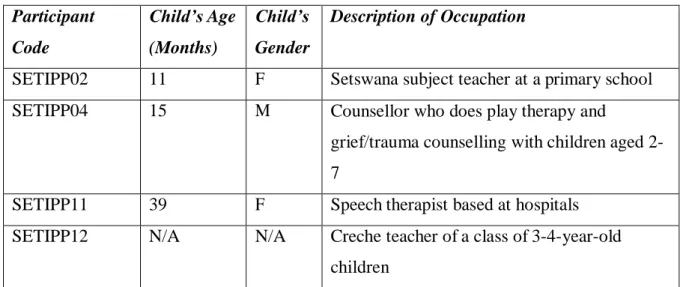
CHILD AND FAMILY DEMOGRAPHICS
- Demographics of Participants
- Age, gender and area distribution
- Children’s caregivers Primary caregiver
- Child’s parents Parents’ age
- Languages Spoken at Home
- Child’s Health and Development .1 Birth age and weight
- Health problems of the child and the child’s family
- Family and Home Structure
- Time spent at home in a year
- Number of adults at home
- Number of children at home
- Number of bedrooms in the home
- SES Factors
- Parent’s education
- Parent’s employment status
- Income and expenditure Annual income
In the FBQ, participants were asked, "Who is the primary caregiver of the child?" and could respond with no more than two primary caregivers. In the FBQ, participants were asked about the marital status of the child's mother and father and could answer married, single, or living with a partner. The FBQ included questions asking about various health aspects of the child and the child's family.
Of the two fathers who fell below the average, both were from the suburban area.
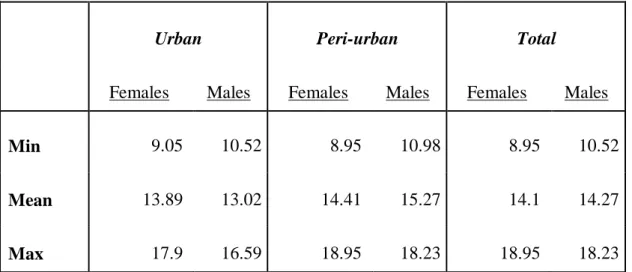
Conclusion
Additionally, 12 of the children were reported to be living in a second home for up to three months of the year. However, half of the mothers were unemployed and most of them lived in the peri-urban area. As Botswana is a multilingual society, it is not surprising that two-thirds of the children were exposed to a language other than Setswana at home.
The second most common language was English, with 16 of the children exposed to it.
RESULTS
Infants' Comprehension of Common Phrases
However, there are large differences, with some children scoring lower at nine months than children at eight months and children at 18 months scoring lower than children at 17 months. In addition, Sections B and C were significantly correlated with age when considered independently (see Table 5.1.c for details of correlations). No correlation was found for Section A because these items are acquired early; of the three items, all 28 participants understood the first two items, while 20 of the 28 participants understood the third item.
There was no phrase on the list that was known by less than 25% of them.
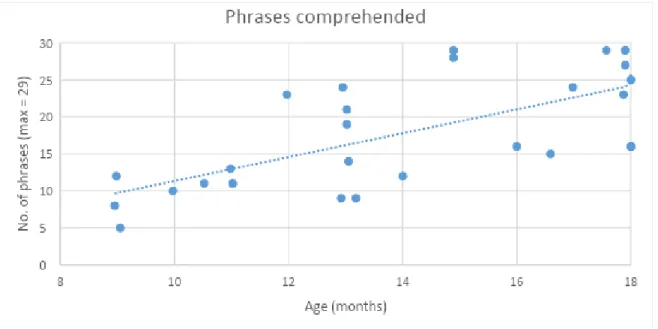
Lexical Comprehension and Production
- Overall scores for comprehension and production
- Comprehension and production according to semantic categories
- Nouns, verbs and other word types
- Individual word analyses
- The effect of individual factors on vocabulary
These are described below as a percentage of the total number of words the children know. Tables 5.2.k and 5.2.l show the frequency of each word, i.e. the percentage of the sample that could understand and produce each of the commonly known words. The demographic factors asked for in the FBQ (discussed in Chapter 4) have some effect on the child's vocabulary scores.
The earliest acquisition of the 20-word milestone was a peri-urban child at 12.95 and an urban child at 14.89 months.
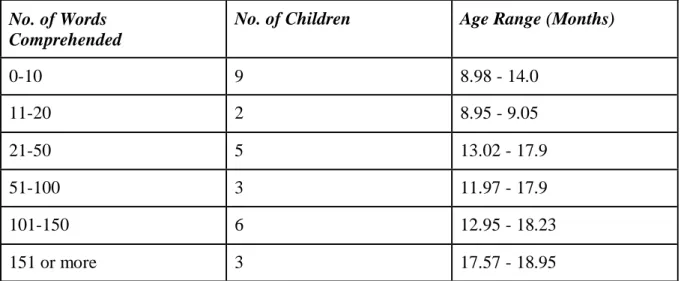
Actions and Gestures
- Overall results
- Results by gesture category
A Pearson correlation of two-tailed significance was performed on the total gesture score compared to the children's individual factors. The mean gesture score is higher than that of lexical comprehension and production across all ages (see Figure 5.3.e). In fact, none of the items in these three categories were produced by more than half of the sample (15 or more children).
It is interesting to note that in the younger age group of eight to twelve months, the gesture scores of the last three categories were quite low.
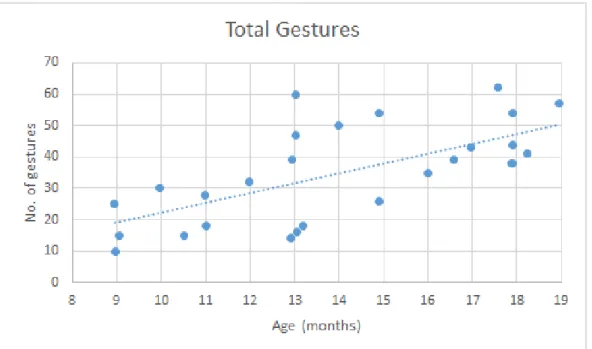
DISCUSSION
Development of Receptive Vocabulary .1 Comprehension of common phrases
- Lexical comprehension
- Lexical comprehension of semantic categories
- Lexical comprehension by word types
The two eight-month-old infants in this sample achieved a mean comprehension score of 10 phrases: a score at the 75th percentile of the sample in Fenson et. In addition, the oldest children in the Mozambican cohort, aged 25 months, scored 80 words. For the sample in the current study, the eight- to 12-month-old age group had a mean comprehension score of 24.6 words, and the 13- to 15-month-old group had a mean comprehension score of 39 words.
The oldest age group in this study at 16 to 18 months had a comprehension score of 122.9 words, which is comparable to the English/Italian subgroup that had a comprehension score of 101-150 words.
Development of Expressive Vocabulary .1 Lexical production
- Lexical production of semantic categories
- Lexical production by word types
- Most commonly produced words
The semantic categories from this list that are also most common in the expressive vocabulary of the cohort of Fenson et. In the English and Italian cohorts compared by Caselli et.al. 1995), nouns dominate the expressive vocabulary and verbs form a very small part of the expressive vocabulary. However, there are still very few verbs in the Setswana cohort, making up 0.8% of the vocabulary, while verbs in English have grown to 2.1% and 2.8%.
Five of the top 21 Setswana words were not found in the English and Italian top words because the item was not included in the American and Italian CDIs and was added during the construction of this CDI.
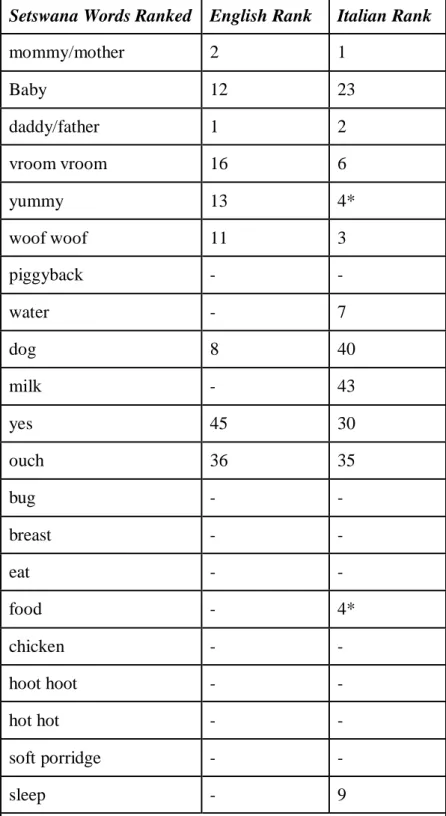
Development of Actions and Gestures
- First communicative gestures
- Games and routines
- Actions with objects
- Pretending to be a parent
- Imitating other adult actions
- Pretend objects
- Other actions and gestures
Of the 14 items in the first gesture subcategory, only four items were significantly correlated with age. Only one of the six items in this subcategory, 'clapping hands', was related to age. Some of the items may be biased toward a demographic with a higher SES and access to more resources, such as certain toys.
For these reasons, the items in this overall subcategory may be biased toward certain demographics, such that half of the items are unrelated to age.
The Effect of SES and Individual Factors .1 Area
- Gender
- Maternal education
- Health issues
- Exposure to other languages
In this study, about a third of the children were cared for by someone other than their mother. In this sample, four out of five mothers with a lower level of education also lived in a suburban environment, and all had an income below the national average and in the lowest tax bracket. In addition, nine out of 10 participants who indicated that their mother had a college degree also indicated that they had an income above the national average, and more than half of them lived in a city.
In the current study, infants who were exposed to a second language for more than 25% of the day scored lower than the monolingual group in the gesture section (see Figure 5.3.d).
CONCLUSION
Summary of Main Findings
Although not statistically significant, the same effect was found with the expressive and receptive vocabulary scores in relation to exposure to another language. Nouns make up the majority of known words in both comprehension and production, as found in many other studies. However, verbs made up about a quarter of the receptive vocabulary, which is a larger proportion than found in Indo-European language studies.
These are among the many interesting findings from this pilot that warrant further investigation.
Limitations
The study also showed that, as expected, babies who learn Setswana develop receptive vocabulary faster than expressive vocabulary. Finally, the version of the CDI used in this pilot was very long for many of the participants to get through, especially the vocabulary section. The official CDIs of other languages have an average of about 350 lexical items, compared to more than 800 items in the version used in this study.
While this was scientifically necessary for the adaptation process, it proved inconvenient for the caregivers, especially those of the youngest children under one, who would eventually respond affirmatively to perhaps 1% of the total number of words in the tool.
Implications and Directions For Further Studies
Several items in the gesture section of the Setswana CDI did not work with this cohort because they involved concepts that were unfamiliar to the children and generally unknown in the context of this population. Assessing the lexicon: validation and developmental data from the Picture Naming Game (PiNG), a new picture naming task for toddlers. Development and initial validation of an Arabic version of the Expanded Trail Making Test: implications for cross-cultural assessment.
I also understand that if I am uncomfortable with some of the questions, I do not have to answer them.
Dipotso go ba Lelwapa
- DITIRAGALO TSA NGWANA WA GAGO, LETSATSI LE LETSATSI
- BOITEKANELO LE KGOLO YA NGWANA
- LOLWAPA LA NGWANA
- KA MMAAGWE NGWANA
- KA RRAAGWE NGWANA
- TSA MO LWAPENG
Ge ngwana wa gago a ekwa maleme a mangwe ka gae, o a kwa diiri tše kae ka letšatši? Ke bana ba bakae bao ba dulago le ngwana wa gago ka lapeng? Araba dipotšišo tša 8 go ya go 11 ge e ba ngwana wa gago a dula ka lapeng le le fapanego mo ngwageng.
Ke batho ba bakae ba bagolo ba mengwaga ya go feta ye 18 bao ba dulago le ngwana ka lapeng le lengwe?
WORDS AND GESTURES – MAFOKO LE DIKETSO
- Dikarolo tsa diele
- Tshimologo ya puo
- Mafoko
- DITIRO LE DIKETSO A. Didirwa tsa ntlha go fetisa molaetsa
- Metshameko
- Go dirisa didirisiwa
- Go etsa motsadi (go tshameka mantlwane)
- Go etsa mogolo (ka didirsiwa kana ka mo go tshamekang) A ngwana wa gago o setse a dira kana a lekeletsa dingwe tsa tse di latelang?
- Didirisiwa tse di tshamekisiwang
Swaya mantšu a ka fase ka botee ka ge ngwana wa gago a a kwešiša, goba a a kwešiša le go a bolela. Ge masea a dutše a ithuta go boledišana, a ka diriša diatla tša ona goba dihlogo tša ona go itlhalosa. Swaya ka fase ga mediro yeo o bonego ngwana wa gago a e dira.
Dira motho yo mogolo (ka didirišwa goba papadi) Na ngwana wa gago o šetše a dirile goba o lekile se sengwe sa tše di latelago?
